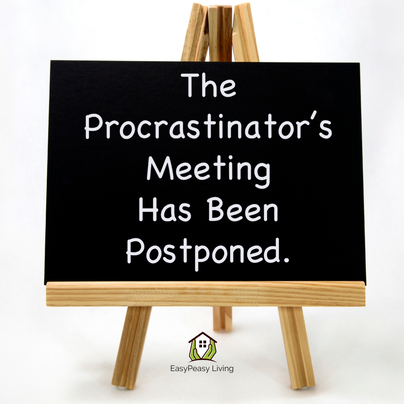 “The gentleman at the next table has ordered you a large portion of unpleasantness. How would you like that served?” “I’ll have it procrastination-style, please.” “Ok, so on a bed of dread with a side of guilt then... served cold?” If you really want to savor the bitter taste of tasks you wish you could avoid, procrastinate. Sounds yummy, no? Then take action to get them off your plate as soon as possible. The only thing worse than being faced with something you dread doing is prolonging the experience and adding to it feelings of guilt, inadequacy, stress and anxiety. But first, it’s worth asking yourself why you are procrastinating in the first place in order to figure out how to stop doing it. There are many reasons you might put off doing things: 1. You find them unpleasant. Figure out how to make them more pleasant, or at least less unpleasant. Work with a friend, listen to music while you work, make a game out of it, plan a reward for afterward, or break it into smaller, more manageable chunks. 2. You would rather do something else. The quicker you get your task done, the sooner you get to focus on the things you enjoy. Not only that, you’ll actually revel in those activities more when you aren’t encumbered by a sense of dread and/or guilt at not tackling your unpleasant task first. By getting the awfulness out of the way, you won’t have to worry about having adequate time to complete it properly. 3. You think if you wait long enough you might not have to do them. This might be correct, but if that turns out to be incorrect, the delay will shorten the time you have available to do it. This will increase your stress level and likely yield substandard results. 4. You aren't sure how to do them. Your first step should be finding the information you need. See this experience as a chance to learn something new and feel accomplished. When you change your attitude and approach it as an opportunity instead of as a chore, you are less likely to dread it. The next time you’re faced with a similar situation, you’ll feel more confident in your ability to meet the challenge. 5. You don't know where to start. Begin with a “preparation step”. Buy supplies you know you’ll need, line up help from a friend or family member, research some information, schedule an appointment, or ask someone else for advice on the best place to start. Once you take that first step, the next one will come easier. The worst thing that could happen is that you miss an important step and have to start over again. At least then you’ll know where to begin, right? And remember, not taking the first step will never get the job done. Where you start isn’t nearly as important as just starting somewhere. 6. You lack the resources you need. Whether you need money, information, assistance, or time, identify and create a plan for acquiring the resources you need. Even if this means you have to wait awhile until you have them in order to begin the task, you can still make progress just by working on obtaining them. 7. You’re afraid of what you might discover. Realize that uncovering a problem is always the first step in fixing it. If you’re avoiding a medical appointment, doing your taxes, or calling the plumber simply because you’re afraid your worst fears will be confirmed, putting it off won’t improve the situation. However, learning the truth sooner may. Perhaps your fears are unfounded (imagine the relief!), or maybe finding out about a problem now will mean fixing it before it gets even worse. At the very least, you’ll reduce your uncertainty and all the anxiety that comes with it. Side note: I'm not usually one to procrastinate...anymore, but when I do, it's almost always because of 4 or 7. It requires lots of self-awareness and conscious effort to avoid falling back into the old habit of putting things off under these circumstances. But I realized a long time ago that it's worth the effort in order to avoid the anxiety-laden aftertaste of my self-indulgence. Whatever your reason for it, procrastination definitely contributes to your level of stress and anxiety. The only remedy is action. Organization can help.
If you find yourself with a heaping plateful of tasks you’d rather avoid, season it with a generous blend of confidence, determination and just a sprinkle of organization, and then gobble it up before it gets cold. Don't miss out! Sign up to have each new EPL Blog post delivered to your inbox each week.
0 Comments
"Procrastination is the thief of time, collar him." -Charles Dickens, David Copperfield  It sneaks in, disguised as an innocent "good reason", and assures you it's harmless. Then it bludgeons your dreams and possibilities and steals all your hope. It kidnaps your creativity and leaves it to starve. And when you finally realize what's happened, it blames you...saying it's all your own fault for having invited it in the first place. Procrastination is a known thief and murderer, stealing time and killing plans for a better, easier, more pleasant existence. So why do we keep on opening the door to it and how do we overcome its charming allure? Recognize it - Ask yourself why you are putting something off. Identifying the real reason will help you to recognize procrastination for what it is, but you have to be honest with yourself.
Plan your counter-attack - Guard against procrastination by establishing a plan for completing the task as soon as you think of it. Having a plan of attack will eliminate unexpected obstacles to getting it done and will make the idea of completing it less daunting.
Call for back up - Get help in holding yourself accountable.
Be a hero - Once you've completed your task, bask in the glow of accomplishment and savor the sense of relief that comes from getting that monkey off your back. You did it! Remember how good this feels the next time you are faced with a task you dread. Overcoming your tendency to procrastinate will empower you to dream big and hope more because you'll have the confidence you need to tackle anything that intrudes on your ability to accomplish your goals. Have you ever noticed that things always tend to break when you are broke...and when you really, really, really, really need them the most?
That's what happened this morning. My husband returned home from his first night shift back at work after a much-needed two weeks off and reported that the brakes in his car were making that dreaded grinding sound. You know the one. It means "Cough up at least $250 immediately" in car language. And of course it didn't happen while he was off and we didn't need both cars so that each of us could get to work. It happened right in the middle of a particularly tight budget week. But it is what it is, and there was no getting around it. We needed that car and couldn't avoid the necessary repairs, so we put our heads together and came up with a solution within five minutes. I was so proud of my husband (aka "Mañana Man") for facing the issue head on instead of avoiding it the way he has often done in the past. I used to tease him about how whenever he noticed the car making a funny noise, he'd just turn up the radio so that he didn't have to hear it anymore. Job done...right?!! We all have stuff we avoid. I avoided our finished basement for years because the carpet and sofa were stained, the kids' toys had taken over, and it was dark and dingy and ugly, and I didn't have the money to get new carpeting or a new sofa. I found myself trying to fit all my stuff into the main level of our house, making that more cluttered than I wanted, just so that I didn't have to go down there as often to get the things I needed. I dreaded doing the laundry, because it meant I had to spend time in that depressing environment. I refused to hang out with my husband or children down there. It felt like a dungeon. Eventually, I got so annoyed at having to relinquish the use of one-third of my house just because it was ugly that I finally decided to do something about it. I painted it, bought slip covers and new drapes, purged all the toys the kids had outgrown and re-organized the rest, and cleaned the carpet. When I was done, I not only liked it again, I spent most of my days working down there. I even made sure we had a Christmas tree down there so that we could open up our gifts in front of the fireplace. It was awesome, and I was left wondering why I hadn't done it sooner...why I had wasted all that precious time avoiding the thing that would lead to such a positive outcome. The work and inconvenience of it was far worse in my head than it was in reality and was well-worth it. It took about three days but I have now been able to enjoy that part of my house for over a year. Winning! One of my favorite shows on TV is "Buried Alive" on Discovery Health Channel. If you haven't heard of it, it's a show about extreme hoarders who decide it's time to get the psychiatric and organizational help they need to clear up their clutter. Avoidance is the main M.O. for practically all of them. They have developed hoarding behaviors as a means of covering up, or avoiding, their emotional pain. They avoid cleaning up and putting things away. They literally build up barriers of stuff to avoid dealing with their nagging spouse or kids. They avoid the reality of their financial issues by continuing to shop for more stuff they don't need with money they don't have. They avoid making repairs in their home and thus often go without power or water for years. Then they begin avoiding relationships because they have to hide their hoarding problem. Life eventually becomes so miserable, the smallest tasks so cumbersome, the mess so paralyzing and their self-esteem so low that they are forced to confront the issue and fix it. And most of them do and then can't believe how wonderful it is not to have maggots all over their kitchen and to be able to take a shower in their own bathroom or sleep in a bed again. They spent so many years bathing in the sink or eating takeout and robbing their kids of their childhoods that they couldn't remember how incredibly easy normal life could be in comparison. One of my clients this week told me that she found herself avoiding looking at the new "Action" folder we set up for her incoming mail and other papers. After asking her several probing questions to get to the bottom of the issue, it came to light that she was afraid she'd make a mistake in filling out a form or would not be able to find some important document she needed in order to submit her health insurance claims. I pointed out to her that there are very few mistakes in life that cannot be corrected, and there is almost always someone somewhere who has a copy of any missing document or who can help you figure out how to achieve your goal without it. Perhaps it will require some inconvenience or may cost time or money you think you don't have, but there is always a solution as long as you look for it instead of avoiding it. But more importantly, finding the solution is how we grow and learn, and isn't that the whole point of living in the first place? To avoid the problem only avoids finding the solution, which in turn avoids learning and growing and living. The old adage, "Never put off until tomorrow that which can be done today" really means, "Never put off the relief and joy and sense of accomplishment you feel when overcoming an obstacle if you can experience it today". So next time you find yourself avoiding an unpleasant task, realize that you are also avoiding the sense of freedom that only comes from having completed it. |
AuthorValerie Sheridan is a professional organizer, wife, mother of two, and Founder/Owner of EasyPeasy Living. Archives
October 2022
Categories
All
|

 RSS Feed
RSS Feed